Abstract
Context
In this work, we did a theoretical exploration of C8F8 (Ib) and its anion radical analogue (IIb) in this work. By investigating the thermochemistry of electron capture, we find that the free energy associated with the conversion of C8H8 (Ia) into its anion radical analogue IIa is of the order of + 92.83 kcal.mol-1, while the conversion of Ib into IIb is − 6.42 kcal.mol-1. Therefore, species IIb is thermodynamically more stable than its neutral analogue. Natural bond orbitals (NBO) analyses revealed that compound Ib exhibits a relative electronic stability as a function of intramolecular delocalisations of the type \({\sigma }_{C-C}\to {\sigma }_{C-F}^{*}\) of the order of 2.70 kcal.mol-1. Similar delocalizations for Ia are energetically lower (1.45 kcal.mol-1). Topological analyses of compounds Ib and IIb indicate that the addition of an electron to Ib enhances the covalency of the C-C bond, as can be seen by the reduction in the ellipticity of the C-C bond. The opposite is observed for Ia, whose addition of the electron (leading to IIa) reduces the covalency of the C-C bond. By comparing the free and packaged forms of the species, it is found that, in the crystalline form, the system will present greater relative stability due to the dispersive interactions involved, as evidenced by non-covalent interactions (NCI) analysis. Finally, it was possible to verify that the manifestation of the current density with a lower paratropic and less antiaromatic character in Ib and IIb point to C8F8 as a strong candidate for electron capture.
Methods
Geometry optimization calculations were carried out, for all monomer structures using the hybrid functional B3LYP-D3 and the 6-31+G(d,p) basis set. To determine the formation thermochemistry of the ions, electronic energy corrections was performed using the DLPNO-CCSD(T)/aug-cc-pVTZ/C method. Starting from the optimised forms, shielding, nuclear magnetic resonance (NMR) spectra employing gauge-independent atomic orbital (GIAO), and NBO calculations were performed for these monomers, using the PBE0 functional and the pCSseg-2 atomic basis set. The magnetochemical analysis of ring currents was performed using the GIMIC formalism. For the topological analysis, it was applied the combination DLPNO-CCSD(T)/aug-cc-pVTZ/C, previously used for correcting the electronic energy.
Graphical Abstract







Similar content being viewed by others
Data availability
This is not applicable.
References
Hopf H, Von Eggers Doering W (2000) Classics in hydrocarbon chemistry: syntheses, concepts, perspectives. Wiley
Biegasiewicz KF, Griffiths JR, Savage GP et al (2015) Cubane: 50 years later. Chem Rev 115:6719–6745. https://doi.org/10.1021/cr500523x
Eaton PE, Cole TW (1964) Cubane. J Am Chem Soc 86:3157–3158. https://doi.org/10.1021/ja01069a041
Fleischer EB (1964) X-ray structure determination of cubane. J Am Chem Soc 86:3889–3890. https://doi.org/10.1021/ja01072a069
Voloshin YZ, Kostromina NA, Krämer RK (2002) Clathrochelates: synthesis, structure and properties. Elsevier Science
Kato T, Yamabe T (2003) Electron–phonon interactions in charged cubic fluorocarbon cluster, (CF)8. J Chem Phys 120:1006–1016. https://doi.org/10.1063/1.1631931
Sugiyama M, Akiyama M, Yonezawa Y et al (2022) Electron in a cube: synthesis and characterization of perfluorocubane as an electron acceptor. Science 377:756–759. https://doi.org/10.1126/science.abq0516
Becke AD (1988) Density-functional exchange-energy approximation with correct asymptotic behavior. Phys Rev A 38:3098–3100. https://doi.org/10.1103/PhysRevA.38.3098
Grimme S (2011) Density functional theory with London dispersion corrections. WIREs Comput Mol Sci 1:211–228. https://doi.org/10.1002/wcms.30
Becke AD (1993) Density-functional thermochemistry. III. The role of exact exchange. J Chem Phys 98:5648–5652. https://doi.org/10.1063/1.464913
Lee C, Yang W, Parr RG (1988) Development of the Colle-Salvetti correlation-energy formula into a functional of the electron density. Phys Rev B 37:785–789. https://doi.org/10.1103/PhysRevB.37.785
Hariharan PC, Pople JA (1973) The influence of polarization functions on molecular orbital hydrogenation energies. Theor Chim Acta 28:213–222. https://doi.org/10.1007/BF00533485
Hehre WJ, Ditchfield R, Pople JA (1972) Self—consistent molecular orbital methods. XII. Further extensions of Gaussian—type basis sets for use in molecular orbital studies of organic molecules. J Chem Phys 56:2257–2261. https://doi.org/10.1063/1.1677527
Riplinger C, Neese F (2013) An efficient and near linear scaling pair natural orbital based local coupled cluster method. J Chem Phys 138:34106. https://doi.org/10.1063/1.4773581
Riplinger C, Sandhoefer B, Hansen A, Neese F (2013) Natural triple excitations in local coupled cluster calculations with pair natural orbitals. J Chem Phys 139:134101. https://doi.org/10.1063/1.4821834
Liakos DG, Sparta M, Kesharwani MK et al (2015) Exploring the accuracy limits of local pair natural orbital coupled-cluster theory. J Chem Theory Comput 11:1525–1539. https://doi.org/10.1021/ct501129s
Liakos DG, Neese F (2015) Is It possible to obtain coupled cluster quality energies at near density functional theory cost? Domain-based local pair natural orbital coupled cluster vs modern density functional theory. J Chem Theory Comput 11:4054–4063. https://doi.org/10.1021/acs.jctc.5b00359
Dunning TH (1989) Gaussian basis sets for use in correlated molecular calculations. I. The atoms boron through neon and hydrogen. J Chem Phys 90:1007–1023. https://doi.org/10.1063/1.456153
Kendall RA, Dunning TH, Harrison RJ (1992) Electron affinities of the first-row atoms revisited. Systematic basis sets and wave functions. J Chem Phys 96:6796–6806. https://doi.org/10.1063/1.462569
Weigend F, Köhn A, Hättig C (2002) Efficient use of the correlation consistent basis sets in resolution of the identity MP2 calculations. J Chem Phys 116:3175–3183. https://doi.org/10.1063/1.1445115
Sandler I, Chen J, Taylor M et al (2021) Accuracy of DLPNO-CCSD(T): effect of basis set and system size. J Phys Chem A 125:1553–1563. https://doi.org/10.1021/acs.jpca.0c11270
Jensen F (2015) Segmented contracted basis sets optimized for nuclear magnetic shielding. J Chem Theory Comput 11:132–138. https://doi.org/10.1021/ct5009526
Jusélius J, Sundholm D (1999) Ab initio determination of the induced ring current in aromatic molecules. Phys Chem Chem Phys 1:3429–3435. https://doi.org/10.1039/A903847G
Cossío FP (2021) 1 - Aromaticity in molecules and transition structures: from atomic and molecular orbitals to simple ring current models. In: Fernandez I (ed) Aromaticity. Elsevier, pp 1–41
Kupka T (2021) Theory and computation of nuclear shielding. The Royal Society of Chemistry
London F (1937) Théorie quantique des courants interatomiques dans les combinaisons aromatiques. J Phys le Radium 8:397–409. https://doi.org/10.1051/jphysrad:01937008010039700
McWeeny R (1962) Perturbation theory for the Fock-Dirac density matrix. Phys Rev 126:1028–1034. https://doi.org/10.1103/PhysRev.126.1028
Ditchfield R (1974) Self-consistent perturbation theory of diamagnetism. Mol Phys 27:789–807. https://doi.org/10.1080/00268977400100711
Wolinski K, Hinton JF, Pulay P (1990) Efficient implementation of the gauge-independent atomic orbital method for NMR chemical shift calculations. J Am Chem Soc 112:8251–8260. https://doi.org/10.1021/ja00179a005
Cheeseman JR, Trucks GW, Keith TA, Frisch MJ (1996) A comparison of models for calculating nuclear magnetic resonance shielding tensors. J Chem Phys 104:5497–5509. https://doi.org/10.1063/1.471789
Ruud K, Helgaker T, Bak KL et al (1993) Hartree-Fock limit magnetizabilities from London orbitals. J Chem Phys 99:3847–3859. https://doi.org/10.1063/1.466131
Carpenter JE, Weinhold F (1988) Analysis of the geometry of the hydroxymethyl radical by the “different hybrids for different spins” natural bond orbital procedure. J Mol Struct THEOCHEM 169:41–62. https://doi.org/10.1016/0166-1280(88)80248-3
Foster JP, Weinhold F (1980) Natural hybrid orbitals. J Am Chem Soc 102:7211–7218. https://doi.org/10.1021/ja00544a007
Reed AE, Weinhold F (1983) Natural bond orbital analysis of near-Hartree–Fock water dimer. J Chem Phys 78:4066–4073. https://doi.org/10.1063/1.445134
Reed AE, Weinstock RB, Weinhold F (1985) Natural population analysis. J Chem Phys 83:735–746. https://doi.org/10.1063/1.449486
Reed AE, Weinhold F (1985) Natural localized molecular orbitals. J Chem Phys 83:1736–1740. https://doi.org/10.1063/1.449360
Reed AE, Curtiss LA, Weinhold F (1988) Intermolecular interactions from a natural bond orbital, donor-acceptor viewpoint. Chem Rev 88:899–926. https://doi.org/10.1021/cr00088a005
Naaman R, Vager Z (1988) The structure of small molecules and ions. Springer, US, Boston, MA
Perdew JP, Burke K, Ernzerhof M (1996) Generalized gradient approximation made simple. Phys Rev Lett 77:3865–3868. https://doi.org/10.1103/PhysRevLett.77.3865
Perdew JP, Burke K, Ernzerhof M (1997) Generalized Gradient approximation made simple. Phys Rev Lett 78:1396–1396. https://doi.org/10.1103/PhysRevLett.78.1396
Rauhalahti M, Taubert S, Sundholm D, Liégeois V (2017) Calculations of current densities for neutral and doubly charged persubstituted benzenes using effective core potentials. Phys Chem Chem Phys 19:7124–7131. https://doi.org/10.1039/C7CP00194K
Sundholm D, Fliegl H, Berger RJF (2016) Calculations of magnetically induced current densities: theory and applications. Wiley Interdiscip Rev Comput Mol Sci 6:639–678. https://doi.org/10.1002/wcms.1270
Semenov VA, Krivdin LB (2020) DFT computational schemes for 1H and 13C NMR chemical shifts of natural products, exemplified by strychnine. Magn Reson Chem 58:56–64. https://doi.org/10.1002/mrc.4922
Liang J, Wang Z, Li J et al (2023) Efficient calculation of NMR shielding constants using composite method approximations and locally dense basis sets. J Chem Theory Comput 19(2):514–523. https://doi.org/10.1021/acs.jctc.2c00933
Fouda AEA, Besley NA (2017) Assessment of basis sets for density functional theory-based calculations of core-electron spectroscopies. Theor Chem Acc 137:6. https://doi.org/10.1007/s00214-017-2181-0
Semenov VA, Krivdin LB (2022) Computational NMR of natural products. Russ Chem Rev 91:RCR5027. https://doi.org/10.1070/RCR5027
Bader RFW (1991) A quantum theory of molecular structure and Its appllcatlons. Chem Rev 91:893–928
Bader RFW (1994) Atoms in molecules: a quantum theory. Clarendon Press
Contreras-García J, Yang W, Johnson ER (2011) Analysis of hydrogen-bond interaction potentials from the electron density: Integration of noncovalent interaction regions. J Phys Chem A 115(45):12983–12990. https://doi.org/10.1021/jp204278k
Lu T, Chen F (2012) Multiwfn: a multifunctional wavefunction analyzer. J Comput Chem 33:580–592. https://doi.org/10.1002/jcc.22885
Humphrey W, Dalke A, Schulten K (1996) VMD: visual molecular dynamics. J Mol Graph 14:33–38
Keith TA (2019) AIMAll (Version 19.10.12), TK Gristmill Software, Overland Park KS. aim.tkgristmill.com
Frisch MJ, Trucks GW, Schlegel HB et al (2013) Gaussian 09
Cremer D, Kraka E (1984) A description of the chemical bond in terms of local properties of electron density and energy. Croat Chem Acta 57:1259–1281
Castro TS, Martins GF, de Alcântara Morais SF, Ferreira DAC (2023) Aromaticity of Cope and Claisen rearrangements. Theor Chem Acc 142:40. https://doi.org/10.1007/s00214-023-02975-0
Acknowledgements
G. F. M. and T. S. C. are grateful to the CAPES for PhD scholarship. D. A. C. F. is grateful to the PET/IQ-UnB/SESu/MEC for the tutor fellowship. We would like to thank the editorial board of JMM, especially the editor Prof Dr Itamar Borges Jr. for improving the final version of the manuscript.
Author information
Authors and Affiliations
Contributions
G.F.M conceived the study performed and carried out the interpretation of the theoretical data. T.S.C. assisted in the execution and interpretation of the NCI and GIMIC calculations. D.A.C.F conceived the work performed and calculated the GIMIC properties, topology, thermochemistry, and NCI. The authors contributed equally to the study.
Corresponding author
Ethics declarations
Ethical approval
This is not applicable.
Competing interests
The authors declare no competing interests.
Additional information
Publisher's Note
Springer Nature remains neutral with regard to jurisdictional claims in published maps and institutional affiliations.
Rights and permissions
Springer Nature or its licensor (e.g. a society or other partner) holds exclusive rights to this article under a publishing agreement with the author(s) or other rightsholder(s); author self-archiving of the accepted manuscript version of this article is solely governed by the terms of such publishing agreement and applicable law.
About this article
Cite this article
Martins, G.F., Castro, T.S. & Ferreira, D.A.C. Theoretical investigation of anion perfluorocubane. J Mol Model 29, 319 (2023). https://doi.org/10.1007/s00894-023-05725-y
Received:
Accepted:
Published:
DOI: https://doi.org/10.1007/s00894-023-05725-y




